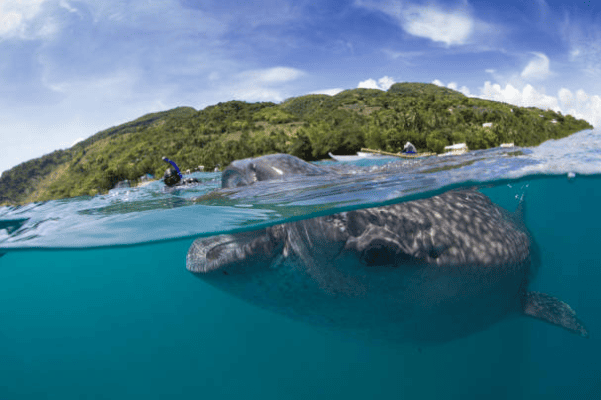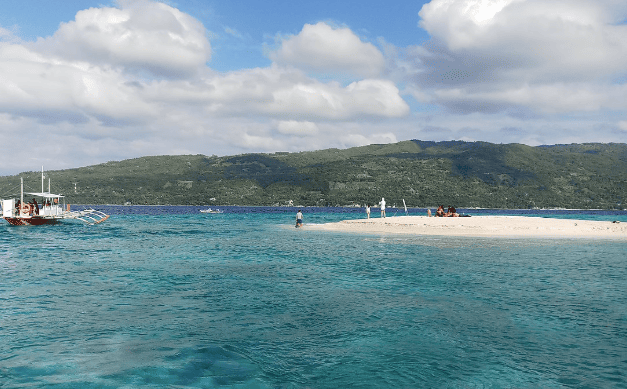Have you ever imagined swimming with whale sharks? At the mention of sharks or whales, most people might feel terrified. Who would dare to swim with such massive creatures? But swimming with whale sharks—remember, whale sharks, not other sharks—is not frightening at all. In fact, it’s an extraordinary experience. That’s exactly how I felt when I swam with the world’s largest fish species in Oslob, Cebu, Philippines.

Here’s how it happened! I first learned about whale sharks while researching tourist spots in Cebu. Initially, I only planned to visit Cebu City and Bohol, which I heard were beautiful. While Googling, I stumbled upon stories about The Giant Whale Shark. It sounded thrilling and exciting, so I changed my plans. Instead of Bohol, I decided to head to Oslob, the place to see and swim with whale sharks.
From Cebu City, Oslob is not too far—about 4 to 5 hours, depending on Cebu’s traffic conditions. There are many buses departing from the South Bus Station, which caters to destinations in southern Cebu. This terminal is located next to Elizabeth Mall, known locally as E Mall.
Three bus operators serve this route: Ceres (yellow buses), Sunrays (blue streaks on white), and Sugbo Transit (orange streaks on white). One-way fares range from 165 to 177 pesos, or about 300 pesos for a round trip. I chose the yellow Ceres bus with air conditioning, which cost 177 pesos. Non-air-conditioned buses are cheaper, at 150 pesos.

I left Cebu City at 12:00 AM and arrived in Oslob around 4:00 PM local time. I had already booked a guesthouse right next to the Whale Shark Center. Upon checking in, I noticed the place was filled with foreign tourists—I was the only Asian guest. Most visitors came to Cebu specifically for the whale shark tour. Locals refer to these gentle giants as butanding.
The tour starts early in the morning. After checking in, I spent the afternoon exploring the guesthouse’s surroundings. Oslob is a small village with not much to do, but it’s bustling with tourists drawn by the whale sharks. I chatted with the guesthouse owner and other travelers, some of whom were regular visitors familiar with the area.
No prior reservations are needed for the whale shark tour. You simply inform your guesthouse host, who will coordinate with the tour organizers. The next morning, we were asked to gather in the lobby. The first trip starts at 6:00 AM, so guests need to assemble an hour earlier. Determined to wake up early, I tried to sleep early too. But someone snored loudly, so I ended up scrolling on my phone before dozing off.

Before 5:00 AM, loud music echoed from the Whale Shark Center. The sun had already risen. I wore comfortable swimwear—flexible shorts, not a bikini, unlike some of the other tourists. We gathered and were taken to the center to register and attend a briefing. Swimming with the whale sharks costs 1,000 pesos for tourists, double the 500 pesos locals pay. If you only want to watch from the boat, the fee is also halved.
For safety, everyone was required to wear life vests. Another rule was to maintain a distance of at least 4–6 meters from the whale sharks—no touching allowed! Although these creatures are harmless, it’s best to respect their space.
Our group from the guesthouse filled an entire boat and got the first trip of the day. The early morning is ideal because the water is clearer, providing a better view of the whale sharks. The boat took us about 200 meters offshore. The guide instructed us to enter the water slowly—no jumping, as it could startle the whale sharks.

The first moment in the water near the whale sharks was nerve-wracking. Even though I knew they weren’t dangerous, fear lingered. I wasn’t the only one; even the foreign tourists were visibly anxious. Every time a whale shark approached, they swam away in a panic, which was amusing—and, admittedly, I did the same.
These whale sharks are enormous—bigger than our boat. They’re about six meters long on average, with adults reaching up to 9.7 meters and weighing 9 tons. I tried capturing photos and videos, but it was challenging due to the waves and overcast sky. At one point, its tail brushed against me, and I instinctively moved away. While trying to record again, I accidentally captured a tourist’s pink bikini instead of the whale shark.
The 30-minute session felt too short. I didn’t get any good photos or videos, but the experience itself was unforgettable. However, repeating the trip wasn’t an option for me, as it would cost another 1,000 pesos—and I was on a budget.
After the tour, the sea became crowded with more tourists waiting for their turn. By midday, the whale sharks were returned to their natural habitat, and Oslob quieted down.

Later that day, I hiked to Tumalog Falls, a nearby attraction. It’s about 15 minutes away by habal-habal (motorcycle taxi), but I decided to walk, which took about an hour. The trek was exhausting, especially since the falls are in the mountains. However, the view from the top was stunning, with beautiful coastal lines and blue waters below.

Reaching Tumalog Falls, I encountered a steep descent to the site. The falls aren’t like typical waterfalls with roaring cascades; instead, they produce a gentle rain-like spray, creating a serene and peaceful ambiance. The turquoise pool at the base isn’t deep, making it ideal for wading rather than swimming.
I stayed at Tumalog Falls until most visitors had left, savoring the tranquility. As the sun began to set, I started the arduous journey back to the guesthouse. Walking uphill, I adopted a backward-walking technique to ease the strain. Other travelers gave me curious looks, but I didn’t mind.
That marked the end of an adventurous and fulfilling day!
